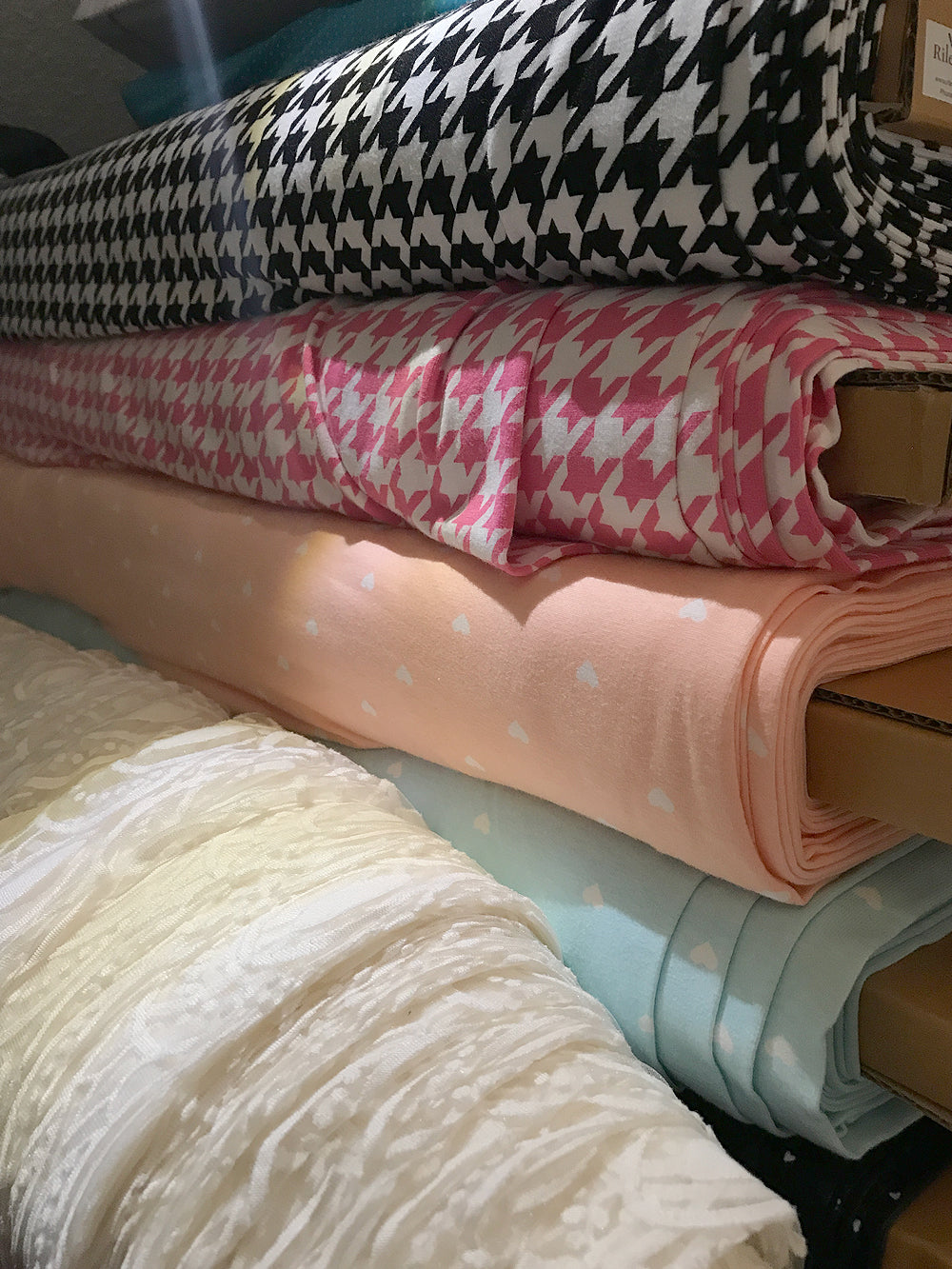Menu
Fabrics Part I: Choosing Fabrics, Knits and Tricot Fabrics

The stretch and recovery and weight of the fabric are matters most when choosing fabrics...all stretch knit jerseys are not equal.🐟🐟🐟🐠🐟🐡🎣
Choosing the wrong material can be the biggest mistake when working with knit specific patterns❗⚠. I don’t recommend using just any stretch woven fabric (even if the word “stretch” is in the name) when your pattern calls for a knit fabric.
When I started teaching sewing classes, I realized just how important it is to start by recognizing and choosing the right materials.
In this blog post I’ll share with you a simple guide to the following:
- Choosing fabric
- Fabric names
- Knit fabrics
- Tricot fabrics
Where do I start? How do I choose a fabric for my next project?
When creating a new garment with a new pattern, if you can, purchase enough of your final chosen fabric for trial garment and final piece. Keep in mind that you might have to make adjustments to the fit of the garment. However, if you use a scrap or decided to cut out an old t-shirt, make sure to compare the stretch and the weight to the final chosen fabric. To measure the stretch (lengthwise and crosswise) preferably use a stretch ruler (photo below) for the weight it will be more of a. If your practice fabric is too different from the one selected for the final garment it will drastically change the fit.
When selecting a beautiful fabric for your project, make sure the stretch and recovery, and the weight (💡Tip: When measuring the stretch, try not to pull to close to the edge of the fabric to get a more accurate reading and to prevent damaging the fabric).
What is stretch and recovery?

When you stretch the fabric and release it, it should spring back to its original state. If it doesn’t, it’s a cheap fabric that will not work for anything other than mopping the floor. Or maybe a shirt for the family pet?

2-way stretch vs. 4-way stretch:
2-way fabrics stretch in only one direction. 4-way fabrics stretch in both directions; lengthwise and crosswise.
How do I find the fabric that I’m looking for?
I hear and see this question in Reddit all the time. The process of making fabric is complex. The quality of the fiber content, and the process of knitting or weaving can lead to several different varying results (end product fabric). Before Googling or asking the one salesperson in the whole fabric warehouse, start by understanding the name of the fabric that you need for your project, by identifying the following 3 simple components:
- Fabric content (fibers used to weave or knit the fabric)
- Fabric construction (how the fabric is made)
- Fabric type (the finishing or type of knitting/weaving)
- Fabric content: Cotton, Nylon, Spandex, Rayon
- Fabric construction: Knit, Woven (can be omitted if there is a distinctive unique fabric name like Marquisette, Ponte de Roma)
- Fabric type: Jersey, Tricot, Interlock, French Terry, Mesh
To put it all together:If I’m making a t-shirt, I’d search for a Cotton Knit Jersey. If I’m making a sweatshirt, I might search for a Modal Spandex Knit French Terry. After you find a fabric you like, then check for fiber content percentage amounts (e.i Cotton 95%, Spandex 5%) and weight (approx. 4-7oz light weight, 8-10oz medium weight, 11oz + heavy weight for knit fabrics).
Some fabric selections for garments produced in my studio

Some of the most commonly used terms is when the fabric content becomes the fabric name: i.e. Cotton Spandex, which is missing an important part of the description (can you guess what it is?) The problem is that with these same fibers the fabric could be a variety of types: i.e. Cotton Spandex Tricot, Cotton Spandex Jersey, Cotton Spandex French Terry, and so on. I hope this helps clarify some of the fabric basics. 🤯 Whaaat❓
Before I start fabrics list, I’d like to address the bad stuff first: Polyester!. ☠ Most of those who know me, would know that I don’t wear or recommend Polyester. It is part of my mission not to carry materials with this fiber in our materials store (I might make some very small exceptions, depending on the company who manufactures it, and the percentage of it in the fabric content)
Polyester, and why I dislike it so much
Polyester is a man-made fiber, practically made from plastic using harmful chemical processes. It causes significant environmental damage, and It’s terrible for the skin. It doesn’t let your skin breathe, causing bacteria and bad odors- even if advertised otherwise as a “special” treated fabric, i.e. wicking. Unfortunately, since it’s cheap and widely available, Polyester is found in most athletic, sleepwear, underwear, and fashion garments.
Knit fabrics are made from knitting weft and coarse fibers or “Weft Knitted Fabrics” like Jerseys Ribbing, and they are made from a variety of fibers and in different weights. The quality is determined by density, quality, length of the yarns, and many other technical factors. They are super comfortable and many times soft, which makes them a great choice for making underwear, pajamas, loungewear and coverups. Most of the knit jerseys nowadays are made from a blend of natural, synthetic or manmade fibers, like Cotton, Bamboo, Modal, Tencel and Rayon with a small percentage of spandex, also known as elastane (or Lycra which is a trademarked brand). I like using medium weight jerseys, (about 8-10oz) for underwear and pajamas. For sports bras or leggings choose heavier fabrics (over 12oz) to prevent show-through. Myself and many others would highly appreciate it. Especially if you are going to wear a legging with a cropped top ✘.
Some of my recommendations are as follow, not only for fabrics, but also when purchasing finished garments:
Organic Cotton At the very minimum, I highly recommend using a light weight organic cotton jersey for the panty gusset lining. Or any other linings.
If you are looking for a luxurious, super soft jerseys for a nightgown or a nice underwear piece, I would choose blends of:
Modal (Trademarked brand) which will not pill or shrink, also it’s more water-absorbent than Cotton. Very soft to the touch and has a fluid drape.
Lyocell (or the trademarked brand Tencel) naturally wrinkle-resistant, natural and environmentally sustainable. Very soft to the touch.
Bamboo fiber besides being sustainable is also antibacterial, and antimicrobial.
Tricot Fabrics
It’s a different type of knitting process called Warp knitted. One of the nicest things about tricot is that it doesn’t fray! Tricots are widely used, and can be found in a variety of weights from very light weight fabrics, even sheer nylons like Glissenette, 20 Denier or Stretch Chiffon tricot to heavy weight like the Nylon/Spandex tricots for swimwear, active and athletic wear, leggings, bodysuits and dancewear. There are some interesting patterns and bright colors available in the market today. Many times they are smooth on one side and slightly textured in the other side. Always check for stretch percentages as some tricots like the 40 denier has very low stretch, about a 10-20% 2-way stretch. Tricot fabrics are durable and some of the Nylon/Spandex fabrics provide somewhat of a cooling effect. Some of my all time swimwear and activewear favorite brands is the Italian companies Carvico or Jersey Lomellina, many of their fabrics are made from recycled Polyamide, the quality is the best, and they provide a long list of testings (how they stand up in chlorine and saltwater, UV rays, etc.).
Lastly, there are also, some stretch and non-stretch woven fabrics that I would consider using for making pajamas, coverups, robes or some loose fitting lingerie. Like Stretch Sateen Cotton.
When it comes to making a bra, bralette, panty, pajama, loungewear or swimwear there are plenty of fabric options. From natural, sustainable fibers, synthetic, to innovative technology fabrics, choosing the right fabrics will completely change the look and the feel of any pattern.
My next Blog post will be Part 2 in this series on Fabrics– Stay Tuned!
Ciao for now!
🥰 Keep in touch! Send messages, Share photos on Instagram @stitchlovestudio, comment, share your experiences.
👀 Check out or visit our Lingerie, Swimwear, Pajamas and Lounge Materials, Fabrics and Patterns at StitchLoveStudio.com.
✍ Sign up to receive news for events, freebies, coupons and sew much more!
📷 If you would like to use any of the photos from this blog, please credit us by adding the following information: "Image by StitchLoveStudio.com". Email me for additional information, requests or written permissions.
- Choosing a selection results in a full page refresh.





2 comments
Roxanna Mills
Bamboo is NOT as eco friendly as it is touted. I do not buy it after reading about it. This link gives the real info on how it is made into fabric and the chemicals that are used. https://thegreenhubonline.com/2017/11/27/how-sustainable-is-bamboo-and-is-it-really-eco-friendly/
Thanks for listening.
kathleen black
Thanks for your explication on fabric types, there is so much to learn. I am looking for fabric to make dolls body and heads. You have helped me to understand the type of fabric I’m am needing
Kathleen 🌻